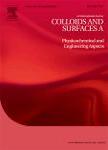版权所有:内蒙古大学图书馆 技术提供:维普资讯• 智图
内蒙古自治区呼和浩特市赛罕区大学西街235号 邮编: 010021

作者机构:Dongguan Univ Technol Sch Environm & Civil Engn Dongguan 523808 Peoples R China Tianjin Univ Sch Earth Syst Sci Tianjin 300072 Peoples R China China Univ Min & Technol Sch Chem & Environm Engn Beijing 100083 Peoples R China
出 版 物:《COLLOIDS AND SURFACES A-PHYSICOCHEMICAL AND ENGINEERING ASPECTS》 (Colloids Surf. A Physicochem. Eng. Asp.)
年 卷 期:2025年第713卷
核心收录:
学科分类:07[理学] 070203[理学-原子与分子物理] 0703[理学-化学] 0702[理学-物理学]
基 金:Dongguan University of Technology Postdoctoral Talent Launch Fund Project Guangdong Basic and Applied Basic Research Foundation [2021B1515020099]
主 题:Catalytic ozonation Coking wastewater Mechanism exploration Water quality analysis
摘 要:Catalysts with high catalytic performance are crucial for the catalytic ozonation of organic wastewater. This study synthesized an efficient, stable, and practical Fe-Mn/Al2O3 ozone catalyst for wastewater treatment using an impregnation calcination method, and applied it in the catalytic ozonation of wastewater. When the concentration of manganese nitrate was 0.15 mol/L, the Mn/Fe ratio was 3:1, the immersion time was 24 h, the calcination temperature was 500 degrees C, and the calcination time was 4 h, the prepared Fe-Mn/Al2O3 had the best catalytic effect on simulated wastewater, with a chemical oxygen demand (COD) removal efficiency of 73.6 %. At the same time, the physicochemical properties of the catalyst were investigated, and the catalytic effect of the catalyst on actual coking wastewater was investigated on a laboratory scale. When the ozone concentration was 20 mg/L, the gas flow rate was 0.5 L/min, the catalyst concentration was 400 g/L, and the pH was 7.02, the actual COD removal efficiency of coking wastewater was 71.6 %. The pilot test results showed that the COD of the treated coking wastewater could stably meet the standard (COD80 mg/L), with an average COD removal rate of about 58.3 %, indicating that the Fe-Mn/Al2O3 had high catalytic activity and good stability. Kinetic analysis showed that the degradation process of organic pollutants followed the pseudo-second-order kinetic equation. The results of water quality analysis such as conventional water quality indicators, fluorescence spectroscopy, and molecular weight classification indicated that the large molecular organic pollutants were efficiently degraded. Mechanism analysis indicated that the active components of the catalyst reacted with ozone through electron transfer to enhance the ozone utilization efficiency and efficiently remove organic pollutants. This study can provide theoretical support and technical reference for the standardized discharge of coking wastewater in the future.